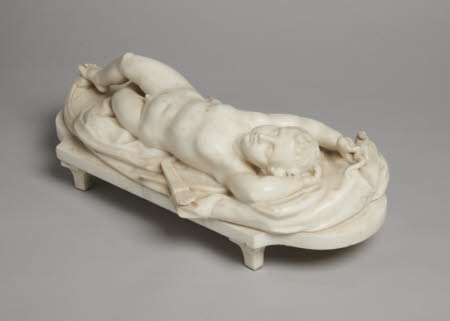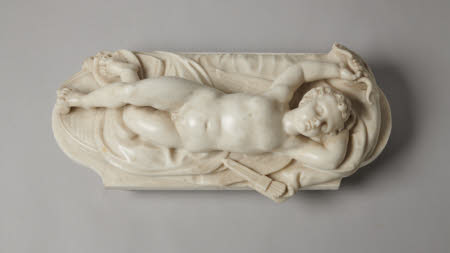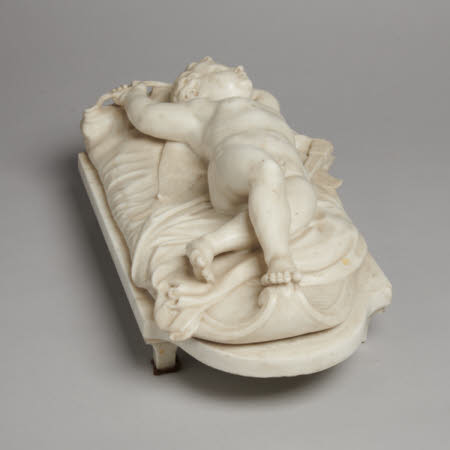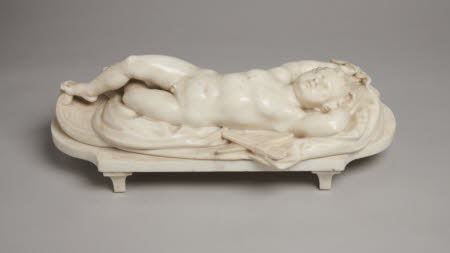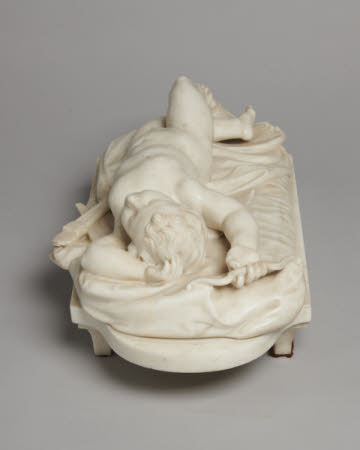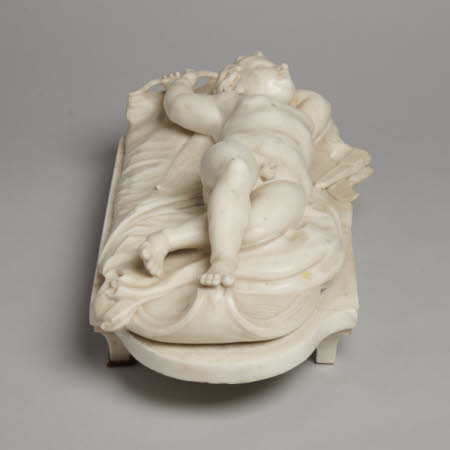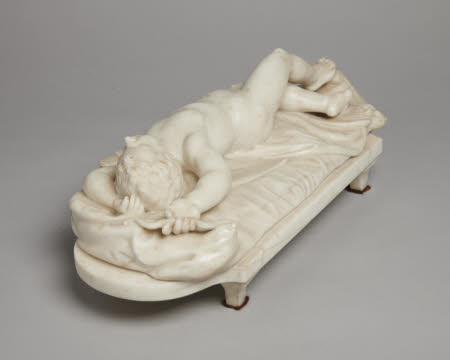The sleeping Cupid or Eros
Netherlandish School
Category
Art / Sculpture
Date
c. 1700 - 1730
Materials
Marble
Measurements
165 x 248 mm; 495 mm (L)
Order this imageCollection
The Argory, County Armagh
NT 565246
Summary
Sculpture, marble; Sleeping Cupid (Eros); Netherlandish; c. 1700-1730. A marble sculpture of Cupid, god of love, lying stretched out asleep on a couch, his bow in his hand.
Full description
A marble sculpture of Cupid (Eros), depicted as a naked boy, winged, who lies stretched out upon a couch, asleep and with his legs crossed and his arms behind his head. In his right hand he grasps his bow, whilst the quiver, filled with arrows, lies to Cupid’s left. Cupid lies on a mattress with ruffled sheets, which rises at one end in a scroll form. The mattress is placed upon a base that is essentially rectangular in form but arched at each end, on four tapering feet. Cupid (Eros in Greek) was the Greek and Roman god of love, the son of Aphrodite/Venus. He is invariably depicted as a winged boy, often carrying a bow with which he would shoot the poisoned darts of love into humans. The concept of the Sleeping Eros, a small winged boy resting as if he has stopped for a nap in the midst of his unceasing labour to cause humans to fall in love, is found in ancient Greek and Roman art, when sleeping Eros sculptures were used to adorn children’s graves, with additional symbols of mortality such as poppy flowers and butterflies. The standard composition was taken over from Roman art by sculptors from the sixteenth century onwards; seventeenth- and eighteenth-century examples can be seen at Anglesey Abbey (NT 516572), Cliveden (NT 766160) and Stourhead (NT 732924). The Cupid in the Argory sculpture is somewhat less innocent than those children, lying as he does sprawled upon his couch, with its tousled sheets. He is perhaps intended to evoke the god sleeping, after a nocturnal visit from his lover Psyche. Originally told by the Roman writer Apuleius, the story of the love affair between the beautiful maiden Psyche and Cupid is one of the most celebrated romantic tales. The two lovers would meet in Cupid’s palace but at Cupid's demand only in darkness. One night, curious to see the appearance of her lover as he slept, Psyche brought an oil lamp close to him, accidentally spilling onto him a drop of hot oil. Cupid and his palace vanished in an instant, the forlorn and bereft Psyche then undergoing a long series of trials on earth, until the lovers were eventually reunited in heaven. This figure of Cupid seems likely to have been made in the Netherlands. There are parallels with late-sixteenth century sculptures such as the pair of standing figures of young boys (putti) in alabaster, attributed to the Antwerp artist Cornelis Floris II de Vriendt (1513-1575), now in the collection of M (Museum Leuwen). The two putti were made in 1563 for the sacrament house of the Celestine monastery in Heverlee, most of which was destroyed in 1796 (Suykerbuyk and van Bruaene 2017, pp. 134-35, figs. 12 and 13). There are also obvious analogies with the sensual Sleeping nymph of c. 1560, again in alabaster, by the sculptor Willem van den Broecke, known as Paludanus (1530-80), in the Rijksmuseum, Amsterdam (Inv. BK-1979-7; Fiorenza 2017, pp. 301-04, fig. 15). However, the use of marble rather than alabaster, as well as the more modern form of the base and its feet, indicate that the sculpture at the Argory must date from later than the sixteenth century. It was probably made in the early decades of the eighteenth century, when some sculptors looked back to the mannerist forms of the late Renaissance. A good comparable example might be the Reclining Venus by the Saxon sculptor Paul Heermann (1673-1732), in the Staatliche Kunstsammlungen in Dresden, which dates from c. 1720 (Inv. ZV 3607; Koja and Kryza-Gersch 2020, pp. 20-21, fig. 11). There are also some parallels with the fluid forms of a terracotta river god, also from 1720, by the Dutch sculptor Jan Baptist Xavery (1697-1742), in the Rijksmuseum (Inv. N.M. 5350; Leeuwenberg 1974, p. 274, no. 373). Jeremy Warren October 2022
Provenance
By descent; given by Walter McGeough Bond (1908-86) in 1979.
Makers and roles
Netherlandish School, sculptor probably Italian School, sculptor
References
Leeuwenberg 1973: Jaap Leeuwenberg, Beeldhouwkunst in het Rijksmuseum. Catalogus, Amsterdam 1973 Smeyers 1987: M. Smeyers, ‘De verdwenen sacramentstoren uit het voormalig Celestijnerklooster te Heverlee. Een werk uit de omgeving van Cornelis Floris‘, Arca Lovaniensis, 15-16 (1986-1987), pp. 251-75. Fiorenza 2017: Giancarlo Fiorenza, ‘Paludanus, alabaster, and the erotic appeal of art in Antwerp’, Netherlands Yearbook for History of Art / Nederlands Kunsthistorisch Jaarboek, 67 (2017), pp. 286-309. Suykerbuyk and van Bruaene 2017: R. Suykerbuyk and A.-L.van Bruaene, ‚Towering piety. Sacrament houses in the Low Countries (1520-1566)’, in Kavaler, Scholten and Woodall, eds., Netherlandish Sculpture of the 16th Century, Leiden/Boston 2017, pp.118-59. Koja and Kryza-Gersch 2020: Stephan Koja and Claudia Kryza-Gersch, eds., Renaissance and Baroque Masterpieces. Dresden Skulpturensammlung, Dresden 2020
